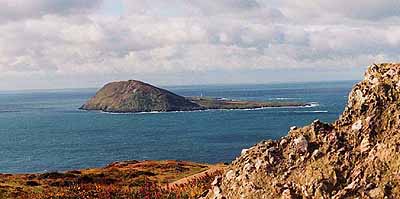
EBK Home
Kingdoms
Royalty
Saints
Pedigrees
Archaeology
King Arthur
Mail David
BARDSEY ISLAND
The Isle of Avalon?
 The
Tradition: Several
old stories claim that Merlin
the Magician's last resting place was Ynys Enlli, otherwise known as Bardsey
Island, off the very tip of the Lleyn Peninsula in Gwynedd. Here
he sleeps in a magical glass castle, probably of his own volition rather
than having been imprisoned by the Lady
of the Lake. He is surrounded by the Thirteen Treasures of
Britain, and is constantly attended by nine bardic companions.
The
Tradition: Several
old stories claim that Merlin
the Magician's last resting place was Ynys Enlli, otherwise known as Bardsey
Island, off the very tip of the Lleyn Peninsula in Gwynedd. Here
he sleeps in a magical glass castle, probably of his own volition rather
than having been imprisoned by the Lady
of the Lake. He is surrounded by the Thirteen Treasures of
Britain, and is constantly attended by nine bardic companions.
The History: Ynys Enlli is an ancient Holy Island whose religious associations pre-date the Christian era as indicated by the name given to it by raiding Vikings, Bardsey - the "Bards' Island". As with so many pagan centres, the Christians took the site over and St. Cadfan and his companions founded a monastery there in AD 546. It became a sort of Iona of Wales, a holy burial place for Royalty and holymen alike. Some 20,000 saints are said to lie beneath its soil: an assertion which led to the Pope proclaiming three pilgrimages to Ynys Enlli to be equal to one to Rome. The place has always been considered something of a health spot. Giraldus Cambrensis declared of the island that "no one dies except from old age".
The Theory: Barber & Pykitt identify Ynys Enlli with the Isle of Avalon where King Arthur was taken to be healed of his wounds after the Battle of Camlann. The battle, they place at nearby Porth Cadlan on the mainland. Merlin's "Castle of Glass" on Ynys Enlli would appear to be the "Chamber of Glass" where Queen Morgan (or Modron) Le Fay lived and worked with her nine sisters (Merlin's companions) to heal King Arthur on the Isle of Avalon. Avalon, meaning "Place of Apples," was an aspect of the Celtic Otherworld, usually called Annwfn: an alternative name appearing throughout Celtic mythology was Caer Wydyr - the "Fort of Glass". Barber & Pykitt believe this to have been a sort of early greenhouse, attached to St. Cadfan's monastery, where Apples could grow, away from Ynys Enlli's treacherous south-west winds and where infirmary patients could recuperate in solarium-like conditions. Perhaps this was the origin of the famous Bardsey Apple Tree which has recently been identified as a unique breed. Today, its apples are the rarest in the World.
Possible Interpretations & Criticism: Barber and Pykitt may have taken things a little far, but their identification of Ynys Enlli with the Isle of Avalon seems quite sound. What better place for King Arthur to eventually be buried than the Insula Sanctorum. A little-known 14th century manuscript known as "The Death of Arthur," apparently written to replace Geoffrey of Monmouth's terse account of the Great King's demise, does actually state that Arthur "gave orders that he should be carried to Gwynedd, for he intended to stay in the Isle of Avalon".
A warm monastic
infirmary, on the island, with weather beating windows, the last vestiges
of a forgotten Roman art, does hold a certain appeal. The glass
building concept is certainly strong in Celtic legend. However, if the
Isle of Avalon were merely the entrance to the Otherworld-Avalon, rather
than Avalon itself, there is no need to look for the means to grow apples
in this desolate place. Such fruits are far away in another dimension that
only mythology can understand.
